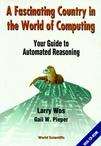计算世界中的迷人国度
出版时间:1999-12 出版社:东南大学出版社 作者:Wos, Larry; Pieper, Gail W.; 页数:587
内容概要
This book shows you ?through examples and puzzles and intriguing questions ?how to make your computer reason logically. To help you, the book includes a CD-ROM with OTTER, the world's most powerful general-purpose reasoning program. The automation of reasoning has advanced markedly in the past few decades, and this book discusses some of the remarkable successes that automated reasoning programs have had in tackling challenging problems in mathematics, logic, program verification, and circuit design. Because the intended audience includes students and teachers, the book provides many exercises (with hints and also answers), as well as tutorial chapters that gently introduce readers to the field of logic and to automated reasoning in general. For more advanced researchers, the book presents challenging questions, many of which are still unsolved.
书籍目录
ForewordPrefaceChapter 1 The Menu, The Map, and the Magic 1.1 The Menu for the Grand Feast 1.2 The Book's Audience 1.3 The Map 1.4 Reasoning in Review 1.5 Reasoning by Computer versus Reasoning by a Person . . 1.6 Obstacles to the Effective Automation of Reasoning . . . 1.6.1 Language 1.6.2 Inference Rules 1.6.3 Assignment Completion 1.6.4 StrategT 1.6.5 Redundancy 1.6.6 Specific versus General Information 1.6.7 Conclusion Retention 1.6.8 Conclusion Generation 1.6.9 Inadequate Focus 1.6.10 Conclusion Repetition 1.6.11 Redundancy-Control Transformations 1.6.12 Size of Deduction Step 1.6.13 Metarules for Program Use 1.6.14 Indexing 1.7 Paradigms for Reasoning and for Research 1.8 The Future of Automated ReasoningChapter 2 Learning Logic by Example 2.1 and, or, not, if-then (implies) 2.2 A Language for Automated Reasoning Programs 2.2.1 Predicates and Constants 2.2.2 Variables 2.2.3 Functions 2.3 Combinations of or with and, Complex if-then, and DeMorgan's Laws 2.4 Assumptions and Axioms, Types of Reasoning, and Proof 2.4.1 Assumptions and Axioms 2.4.2 Types of Reasoning, Inference Rules 2.4.3 Proof 2.5 SummaryChapter 3 Automated Reasoning in Full 3.1 Logic 3.1.1 and 3.1.2 or 3.1.3 not 3.1.4 if-then and implies 3.1.5 is-equivalent-to 3.1.6 Relationships and Laws in Logic 3.2 A Language Understood by an Automated Reasoning Program . 3.2.1 Variables 3.3 Submitting a Problem to a Reasoning Program 3.3.1 Assumptions and Axioms 3.3.2 Special Facts and the Special Hypothesis 3.3.3 Denial of the Goal or Theorem 3.4 Inference Rules 3.4.1 Unification 3.4.2 Binary Resolution 3.4.3 UR-Resolution 3.4.4 Hyperresolution 3.4.5 Paramodulation 3.4.6 Other Inference Rules 3.5 The Empty Clause 3.6 Proof by Contradiction 3.7 Demodulation 3.8 Subsumption 3.9 Strategy 3.9.1 The Set of Support Strategy 3.9.2 Weighting 3.9.3 Unit Preference Strategy 3.9.4 Other Strategies ……Chapter 4 Logic Circuit DesignChapter 5 Logic Circuit ValidationChapter 6 Research in MathematicsChapter 7 Research in Formal LogicChapter 8 The Formal Treatment of Automated ReasoningChapter 9 Wos's Biased Guide for the Effective Use of OTTERChapter 10 An Author's Appraisal of His PapersChapter 11 Open Questions, Hard Problems, Intriguing ChallengesChapter 12 Epilogue and After-Dinner LiqueurAppendix A Featuring Input Files, Proofs, and Output File FragmentsReferencesIndex
图书封面
评论、评分、阅读与下载
用户评论 (总计0条)
相关图书
- 非线性重力动力学
- 信息技术及媒体经济ECONOMICS OF INFORMATION TECHNOLOGY AND THE MEDIA
- 统计力学STATISTICAL MECHANICS
- 基金组合投资管理
- 浙江省农业地质环境调查评价方法技术
- 年度学术2007
- 安全快捷驾驶爱车
- 农林信息技术
- 河北抚宁、曲阳晚古生代地层及植物群
- 论美国的民主
- 中国社会思想史资料选辑
- 民国卷-中国社会思想史资料选辑(上下)
- 中国社会思想史资料选辑
- 论民主
- 美国历届总统就职演说全集
- 毛纺生产技术275问
- 清梳联合机使用手册
- VCD/DVD机常见故障实修演练
- 西伯利亚历险记-我的第一本科学漫画书
- 中国西部开发金融制度调查报告
- 射天狼
- 成语描红/柳体楷书描红系列
- 浙江省土壤地球化学背景值
- 浙江省农业地质环境GIS设计与实现
- 浙江省特色农产品立地地质背景研究
